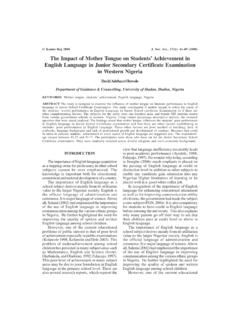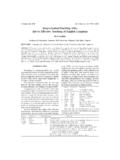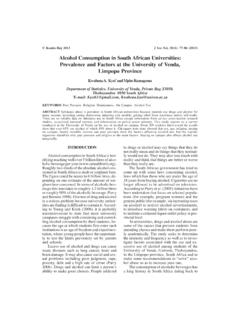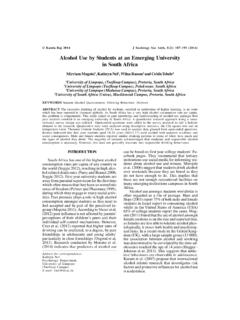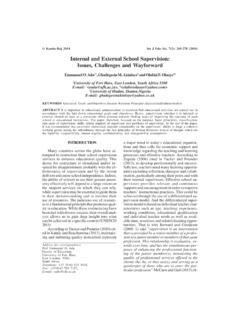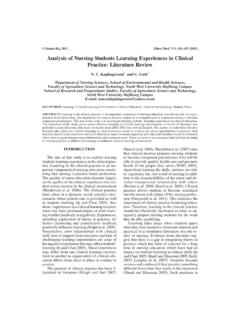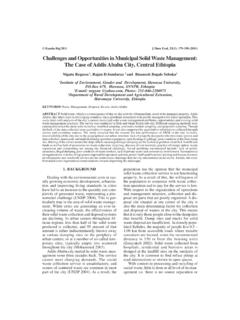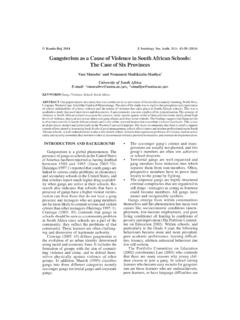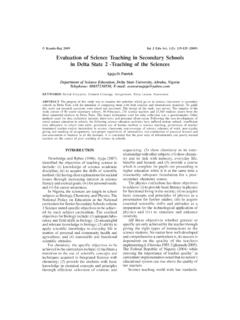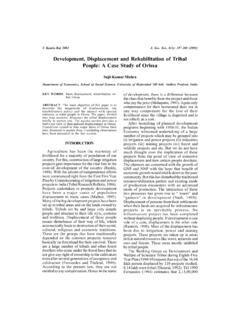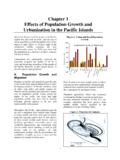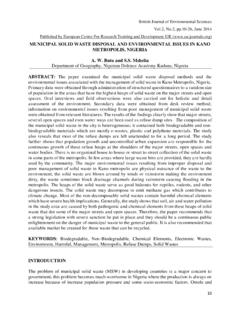Transcription of Child-Headed Households and Educational …
1 Child-Headed Households and Educational Problems inUrban Zimbabwe: The Case of Dikwindi PrimarySchool in Masvingo UrbanVirginia Gubwe1, Pascal Gubwe2 and Stephen Mago31 CBZ Masvingo, Zimbabwe2 Great Zimbabwe University, Box 1235, Masvingo, Zimbabwe3 University of Fort Hare, Department of Development Studies, P. Bag X1314,Alice, 5700, South AfricaCell: +27 846969043, E-mail: Family. child . Problems. Poverty. HIV/AIDSABSTRACT The present research investigates the Educational problems faced by Child-Headed Households inMasvingo, Zimbabwe. These Households are a result of challenges such as divorce, domestic violence, and parentaldeaths (mainly due to HIV and AIDS).
2 Since Zimbabwean families are traditionally extended, the increase in thenumber of orphans puts pressure on relatives who have to fend for additional children. Child-Headed householdarrangements seem to represent a new coping mechanism for orphans in Zimbabwe. Community-based organizations(CBOs) also help extended families to carry the burden of orphans. Using a qualitative research methodology anda case study design, the paper investigates the impact of Child-Headed Households at Dikwindi primary School inMasvingo random and purposive sampling techniques were used to select participants.
3 Data werecollected through interviews, questionnaires and observations. Research findings established that HIV/AIDS was themajor cause of Child-Headed Households . It was also established that Child-Headed Households face a number ofsocio-economic problems. Thus, it was recommended that Child-Headed families should be supported by governmentand other parapublic institutions. The present research contributes to the burgeoning body of knowledge on Child-Headed families and Child-Headed Households are generally con-sidered to be those where the main caregiver isyounger than 18 years of age (Sloth-Nielsen2004: 1 in Anti Essay 2012: 1).
4 The family is agroup of individuals with a continuing legal,genetic or emotional relationship (Gladding 2002;see also Ibebuike et al. 2014 and Mavise 2011 forother family definitions). Society relies on thefamily group to provide the economic and pro-tective needs of individuals, especially, child rearing practices equip a child withrelevant skills, norms, values and attitudes thatmake him/her fit well in the society. However,with the advent of urbanization, most peopleabandon their families and seek greener pasturesin the cities. The problem of child - headedhouseholds (Ibebuike et al. 2014; LeRoux-Kemp2013; Mavise 2011) seems to be pervasive indeveloping countries, especially in attainment of independence in Zimba-bwe (1980) brought massive changes in familylifestyles.
5 This was due to movement of peopleinto various parts of the country and the worldin search of greener pastures. This, therefore,led to changes in children s life styles (see forexample, Mavise 2011). Skolnick and Skolkin(1991: 82) echo that Middle class people moveto different parts of the world to live and work .The Zimbabwean socio-economic crisis (2000to 2009) instigated migration of people into the diaspora . Consequently some parents di-vorced and others died due to HIV/AIDS oroverworking in foreign lands. This has there-fore led to a number of children living in Child-Headed Households . As observed by Ash(1973), such children will be vulnerable to anumber of problems such as lack of parentalguidance, physical abuse, and other harsh liv-ing conditions (Zhangazha 2014).
6 Boyden (1987) posits that the negligent be-haviour of children is yet another aspect notwell understood. Apart from specific symptomssuch as physical injuries, negligence can lead tospecific anxiety symptoms such as nightmares,loss of bladder control, sexually transmitted dis-eases, and depression, loss of confidence andloss of self-esteem. Piaget (1958) (a renownedbehavioural theorist) suggests that early child -hood experiences affect one s adult life. Usuallyabused children will end up fearing anybody Kamla-Raj 2015J Sociology Soc Anth, 6(2): 293-301 (2015)294 VIRGINIA GUBWE, PASCAL GUBWE AND STEPHEN MAGO similar to their abusers.
7 They can also be affect-ed in their school work, and in some cases, theytend to bully others or live careless to Zhangazha (2014: 1), ..variousdeprivations faced by urban children that retardtheir physical, social and economic develop-ment. It is therefore against this backgroundthat the paper sought to examine the education-al challenges faced by children child -headedhouseholds at Dikwindi Primary of the ProblemThe present research sought to investigatethe prevalence of Child-Headed Households inMasvingo urban area. Dikwindi Primary Schoolhas many children living in Child-Headed house-holds. This information was obtained throughone of the researchers who was the chairpersonof Isheanopa (interpreted God gives ), club atthe school.
8 The club was established to helppoor pupils with school fees, uniforms and sta-tionery. The majority of pupils benefiting fromthe club come from Child-Headed families. Oneof the researchers, a teacher at the school, not-ed that individual record books showed manycases of orphans, deceased parents, separatedparents, cross border traders or parents in the diaspora .Objectives of the PaperThe main objective of the paper was to in-vestigate the Educational problems faced bychild- headed families in Masvingo using thecase of Dikwindi Primary school. Sub-objectivesincluded finding out the causes of child headedfamilies and other social problems that affectchild- headed families.
9 It was also imperative toestablish the kind of assistance needed by ReviewInternationally, Child-Headed householdshave not been known to society for a long peri-od of time (see for example Ibebuike et al. 2014).They emerged as an alternative family structurein order to adapt to changing social realities (seeMavise 2011 for further discussions). Bequle(2007: 89) viewed that, there is a famous Africanadage that says It takes a village to raise a child .The saying points to the idea, cherished by mostAfrican societies, that children are a communalresponsibility and the extended family is a safe-ty net for orphans. This safety net, as propound-ed by Arvidson (1996), is now stretched to itslimits by the effects of war(for example in Soma-lia), genocide (such as in Rwanda), armed con-flict (such as in DR Congo), family disintegra-tion and, most importantly, the HIV/AIDS pan-demic (Maqoko and Dreyer 2007).
10 International Perspective on Causes ofChild- headed HouseholdsThe first reports of large numbers of Child-Headed Households were made in the late 1980sin the Rakai district of Uganda (Plan 2005). Fos-ter-Fishman et al. (1998) in Plan (2005), mentionsthat until that time, orphans in Africa did notexist due to extended families within the Africanculture. The kinship system took orphans intoits care. According to the national orphans andvulnerable children s policy of Uganda, ninehundred and forty thousand (940 000) children fourteen percent (14%) of their child popula-tion had been orphaned by HIV/AIDS by theyear 2003 (Ministry of Gender, in Plan 2005).
